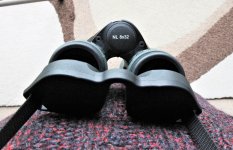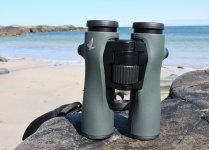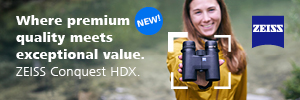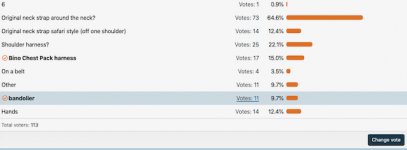Following my comparison of Swarovski’s NL 8x32 with Zeiss’s SF 8x32 (Swarovski NL vs Zeiss SF: a personal comparison of two 8x32s. ) I undertook to take the NL to the Isle of Islay and give it a good workout in genuine field conditions, so that it could demonstrate its full capabilities. As much as I found the comparison a fascinating project, many members will know that I much prefer to assess binoculars by observing nature. As a result I will not be referring to any other models during this review apart from reminding us all about the relative retail prices of the SF (the NL’s most obvious competitor) and NL that I found on the internet:
SF 8x32 £1979 $2,250 €2,162
NL 8x32 £1980 $2,550 €2,390
I will begin with a look at NL’s handling. The body shape with it’s pronounced ‘waist’ has proved a little controversial, with Birdforum members split on whether they like it or not. Unsurprisingly I remained similarly undecided having days when the slinky body shape seemed designed to fit my hands, and other days when I missed the reassurance of more substantial optical tubes to grip. Suffice to say I certainly did not actively dislike the body shape and remain open-minded about it. The eyecups, with their 6 available positions were perfect in that I could easily find exactly the right position whether wearing spectacles or not.
I mentioned in my comparison test that the speed of focus of the NL is the slowest I have ever tested, but in the west of Scotland, where the density of species is lower than in England or (especially) in continental Europe, this was never an issue and the feel of the focus action was superb if slightly uneven. It’s slow speed would be a problem for me in habitats such as lowland wetlands like Vendres in the Languedoc, or Grote Peele in the Netherlands, or the Federsee in Germany, where birds, dragonflies and butterflies appear in rapid succession at different distances. Observers who like the image to ‘snap’ into focus might also be disappointed by the slow speed at which sharp focus arrives.
To get down to the nitty-gritty, NL is capable of delivering images as good as the very best I have ever seen, with especially clean whites, natural colours, excellent contrast and perceived sharpness.
Around our rental cottage on Islay, there is a substantial population of Brown Hares that graze very close to the cottage and provide superb viewing opportunities of these beautiful animals. On one occasion, after a period of rain, one them settled down to groom nearby and through the NL’s it was abundantly clear that to call them ‘brown’ is to entirely misrepresent the variety of colour in their pelage. On its back, which was still a little wet, the fur was a sandy colour flecked with black, down its flanks, the black flecks disappeared and on the lower flanks there glowed the most intensely red-ginger fur, while underneath, its belly was a dazzling creamy-white. I could say more about its eyes, the black tips to its ears, or that they glowed pink when the sun shone through them, but I hope this brief description conveys the richness of the NL’s imaging.
Birds that are primarily black and white don’t sound as though they offer much opportunity for binoculars to demonstrate their colour fidelity, but actually they do. Take the Oystercatchers that roamed our local shores. Their black plumage was actually a kaleidoscope of different tones of black. Depending on the angle of the light falling on it, some of it seeming to suck the light into itself and appear the most intense black, while other parts glinted glossily and still other surfaces appeared just as intensely black but had a soft matt or even silky appearance. The NLs really teased out the subtleties of these details and never more so than when viewing Wheatear males. Is that tone on the mantle grey, or does it have a hint of blue? It is blue/grey to my eyes, and so elegant, contrasted gorgeously by the black of its eye-patch (which looks like nothing so much as a bandit’s mask) and the warm buff on its throat.
All of these tonalities and details were abundantly clear through the NLs but with one proviso. The day had to be cloudy or you were pointing your NLs away from the habitat under the sun. For example, after enjoying views of a Wheatear only a few metres away to the north of us, turning around to view another on the ground to the south, with the bright sun in the sky above, the view was marred somewhat by two pale ghosts of glare, and a shift of my eye positions to try to eliminate these distractions only caused the glare to flare up to cover half the field of view, sucking the contrast, colour and detail out of it. What a shame. And this was repeated every time I pointed the NL’s at anything that was under the sun. Pointing them anywhere a bit north of east or west or towards north itself and there was the full richness of its imaging, pointing them south and here was the glare again, sometimes just the small ghosts, sometime covering large areas of the field of view. Amazingly we had almost 2 weeks of unbroken sunshine and clear blue skies (see photo of the NL below), and this really brought home the NL’s susceptibility to glare.
It may be that with practice an observer to learn to minimise the glare to just the two small ghosts by careful positioning of the NLs in relation to the eyes but it would need considerable patience and dedication. I repeat that this was only encountered on sunny days and when pointing the binos at subjects under that half of the sky dominated by the sun. On cloudy days I never encountered this and even on bright days if the sun was covered by a cloud this meant glare did not appear. Overall then, glare didn’t occur too frequently and was sometimes of a minor nature. I have to say though that I did find it distracted my attention from the subject I was trying to observe.
Wet days were another source of frustration due to the ocular guard (rainguard) being such a tight fit over the eyecups. They were difficult to fit on, and difficult to take off, causing delays in getting views of subjects seen in the rain and allowing rain onto the eyepieces. Not only this, when pulling the ocular guard off the eyecups, it would sometimes pull one of the eyecups up out of position, requiring it to be repositioned during which more rain fell on the eyepieces. In desperation I tried letting the ocular guard simply rest over the top of the eyecups but no matter how careful I was, the guard always ended up slipping off them enough to expose half of the eyepieces (see the photo below). Adding together the delays in being able to look through the NLs and the amount of raindrops that landed on the eyepieces, the NLs were simply unusable in rainy conditions.
To correct this one would need a different after-market ocular guard but this would need bigger than normal slots for the strap just like the standard one has because of the need to allow the studs that secure the Field Pro strap to pass through them. To fit a different ocular guard one might need to discard the Field Pro strap (nearly £60 of strap) unless it can be used with standard strap lugs, use the adapters to allow the use of standard straps and maybe buy a new strap as well. Phew!
I know from my own experience in the rubber industry that moulded rubber products can shrink slightly when they are released from the mould and cool down. I suspect that this is what has happened with ocular guard due to a small miscalculation when designing the moulds, but to rectify this would require re-machining the moulds or producing new ones and so this solution would need an investment. I hope that Swarovski solves this issue and of course this might already have happened.
While we are talking about the Field Pro strap I should mention that the NL arrived with the strap already fitted and what is more, fitted by one of the most competent and experienced dealers in the business. It was a shock therefore when, as I sat down on a seat on the stern of the ferry to Islay to set off to the island, the strap came undone from the binoculars on one side and the binos fell towards the steel deck, fortunately just landing on my knees just as my backside arrived on the seat and I was able to stop the instrument from falling further. That could have been much worse! I re-attached the strap and didn’t have any further issues like this but it took a few minutes for my heart-rate to return to normal and frankly, it did knock my confidence in the Field Pro strap.
I can barely decide how to sum this up but here goes: NL8x32 is capable of delivering views of the very highest quality and while I found its susceptibility to glare distracting, for the majority of the time this wasn’t an issue. It was disappointing that the ocular guard was not effective at keeping rain off the eyepieces and this made the NL impractical to use on rainy days. Hopefully one could replace the ocular guard with an aftermarket one that is effective and since the accidental detaching of one end of the strap from the binos did not happen again this should mean that this incident was a one-off.
Using and enjoying this model in the field has really hammered home two questions about Swarovski. The first is, how can it be that Swaro has invested so much time and money on the Field Pro Strap Mk1 (with screw-down strap locks) and the Mk2 version (with lever-action strap locks), not to mention Gloves for use with binoculars, and yet is selling NL 8x32 with a stylish-looking ocular guard that simply doesn’t work, and actually pulls eyecups out of position? Similarly, the second is, having developed such a fine optical train, how did it happen that development was stopped before the tendency to glare was dealt with? The only explanation I can think of is that higher management moved the technical teams onto other projects, which were deemed to have a higher priority, before they could deal with these issues.
My thanks go to Netherland’s optics dealer, Jan van Daalen, for the loan of this review unit for such a long period of time: veel dank, broer.
Lee


SF 8x32 £1979 $2,250 €2,162
NL 8x32 £1980 $2,550 €2,390
I will begin with a look at NL’s handling. The body shape with it’s pronounced ‘waist’ has proved a little controversial, with Birdforum members split on whether they like it or not. Unsurprisingly I remained similarly undecided having days when the slinky body shape seemed designed to fit my hands, and other days when I missed the reassurance of more substantial optical tubes to grip. Suffice to say I certainly did not actively dislike the body shape and remain open-minded about it. The eyecups, with their 6 available positions were perfect in that I could easily find exactly the right position whether wearing spectacles or not.
I mentioned in my comparison test that the speed of focus of the NL is the slowest I have ever tested, but in the west of Scotland, where the density of species is lower than in England or (especially) in continental Europe, this was never an issue and the feel of the focus action was superb if slightly uneven. It’s slow speed would be a problem for me in habitats such as lowland wetlands like Vendres in the Languedoc, or Grote Peele in the Netherlands, or the Federsee in Germany, where birds, dragonflies and butterflies appear in rapid succession at different distances. Observers who like the image to ‘snap’ into focus might also be disappointed by the slow speed at which sharp focus arrives.
To get down to the nitty-gritty, NL is capable of delivering images as good as the very best I have ever seen, with especially clean whites, natural colours, excellent contrast and perceived sharpness.
Around our rental cottage on Islay, there is a substantial population of Brown Hares that graze very close to the cottage and provide superb viewing opportunities of these beautiful animals. On one occasion, after a period of rain, one them settled down to groom nearby and through the NL’s it was abundantly clear that to call them ‘brown’ is to entirely misrepresent the variety of colour in their pelage. On its back, which was still a little wet, the fur was a sandy colour flecked with black, down its flanks, the black flecks disappeared and on the lower flanks there glowed the most intensely red-ginger fur, while underneath, its belly was a dazzling creamy-white. I could say more about its eyes, the black tips to its ears, or that they glowed pink when the sun shone through them, but I hope this brief description conveys the richness of the NL’s imaging.
Birds that are primarily black and white don’t sound as though they offer much opportunity for binoculars to demonstrate their colour fidelity, but actually they do. Take the Oystercatchers that roamed our local shores. Their black plumage was actually a kaleidoscope of different tones of black. Depending on the angle of the light falling on it, some of it seeming to suck the light into itself and appear the most intense black, while other parts glinted glossily and still other surfaces appeared just as intensely black but had a soft matt or even silky appearance. The NLs really teased out the subtleties of these details and never more so than when viewing Wheatear males. Is that tone on the mantle grey, or does it have a hint of blue? It is blue/grey to my eyes, and so elegant, contrasted gorgeously by the black of its eye-patch (which looks like nothing so much as a bandit’s mask) and the warm buff on its throat.
All of these tonalities and details were abundantly clear through the NLs but with one proviso. The day had to be cloudy or you were pointing your NLs away from the habitat under the sun. For example, after enjoying views of a Wheatear only a few metres away to the north of us, turning around to view another on the ground to the south, with the bright sun in the sky above, the view was marred somewhat by two pale ghosts of glare, and a shift of my eye positions to try to eliminate these distractions only caused the glare to flare up to cover half the field of view, sucking the contrast, colour and detail out of it. What a shame. And this was repeated every time I pointed the NL’s at anything that was under the sun. Pointing them anywhere a bit north of east or west or towards north itself and there was the full richness of its imaging, pointing them south and here was the glare again, sometimes just the small ghosts, sometime covering large areas of the field of view. Amazingly we had almost 2 weeks of unbroken sunshine and clear blue skies (see photo of the NL below), and this really brought home the NL’s susceptibility to glare.
It may be that with practice an observer to learn to minimise the glare to just the two small ghosts by careful positioning of the NLs in relation to the eyes but it would need considerable patience and dedication. I repeat that this was only encountered on sunny days and when pointing the binos at subjects under that half of the sky dominated by the sun. On cloudy days I never encountered this and even on bright days if the sun was covered by a cloud this meant glare did not appear. Overall then, glare didn’t occur too frequently and was sometimes of a minor nature. I have to say though that I did find it distracted my attention from the subject I was trying to observe.
Wet days were another source of frustration due to the ocular guard (rainguard) being such a tight fit over the eyecups. They were difficult to fit on, and difficult to take off, causing delays in getting views of subjects seen in the rain and allowing rain onto the eyepieces. Not only this, when pulling the ocular guard off the eyecups, it would sometimes pull one of the eyecups up out of position, requiring it to be repositioned during which more rain fell on the eyepieces. In desperation I tried letting the ocular guard simply rest over the top of the eyecups but no matter how careful I was, the guard always ended up slipping off them enough to expose half of the eyepieces (see the photo below). Adding together the delays in being able to look through the NLs and the amount of raindrops that landed on the eyepieces, the NLs were simply unusable in rainy conditions.
To correct this one would need a different after-market ocular guard but this would need bigger than normal slots for the strap just like the standard one has because of the need to allow the studs that secure the Field Pro strap to pass through them. To fit a different ocular guard one might need to discard the Field Pro strap (nearly £60 of strap) unless it can be used with standard strap lugs, use the adapters to allow the use of standard straps and maybe buy a new strap as well. Phew!
I know from my own experience in the rubber industry that moulded rubber products can shrink slightly when they are released from the mould and cool down. I suspect that this is what has happened with ocular guard due to a small miscalculation when designing the moulds, but to rectify this would require re-machining the moulds or producing new ones and so this solution would need an investment. I hope that Swarovski solves this issue and of course this might already have happened.
While we are talking about the Field Pro strap I should mention that the NL arrived with the strap already fitted and what is more, fitted by one of the most competent and experienced dealers in the business. It was a shock therefore when, as I sat down on a seat on the stern of the ferry to Islay to set off to the island, the strap came undone from the binoculars on one side and the binos fell towards the steel deck, fortunately just landing on my knees just as my backside arrived on the seat and I was able to stop the instrument from falling further. That could have been much worse! I re-attached the strap and didn’t have any further issues like this but it took a few minutes for my heart-rate to return to normal and frankly, it did knock my confidence in the Field Pro strap.
I can barely decide how to sum this up but here goes: NL8x32 is capable of delivering views of the very highest quality and while I found its susceptibility to glare distracting, for the majority of the time this wasn’t an issue. It was disappointing that the ocular guard was not effective at keeping rain off the eyepieces and this made the NL impractical to use on rainy days. Hopefully one could replace the ocular guard with an aftermarket one that is effective and since the accidental detaching of one end of the strap from the binos did not happen again this should mean that this incident was a one-off.
Using and enjoying this model in the field has really hammered home two questions about Swarovski. The first is, how can it be that Swaro has invested so much time and money on the Field Pro Strap Mk1 (with screw-down strap locks) and the Mk2 version (with lever-action strap locks), not to mention Gloves for use with binoculars, and yet is selling NL 8x32 with a stylish-looking ocular guard that simply doesn’t work, and actually pulls eyecups out of position? Similarly, the second is, having developed such a fine optical train, how did it happen that development was stopped before the tendency to glare was dealt with? The only explanation I can think of is that higher management moved the technical teams onto other projects, which were deemed to have a higher priority, before they could deal with these issues.
My thanks go to Netherland’s optics dealer, Jan van Daalen, for the loan of this review unit for such a long period of time: veel dank, broer.
Lee


Last edited:










